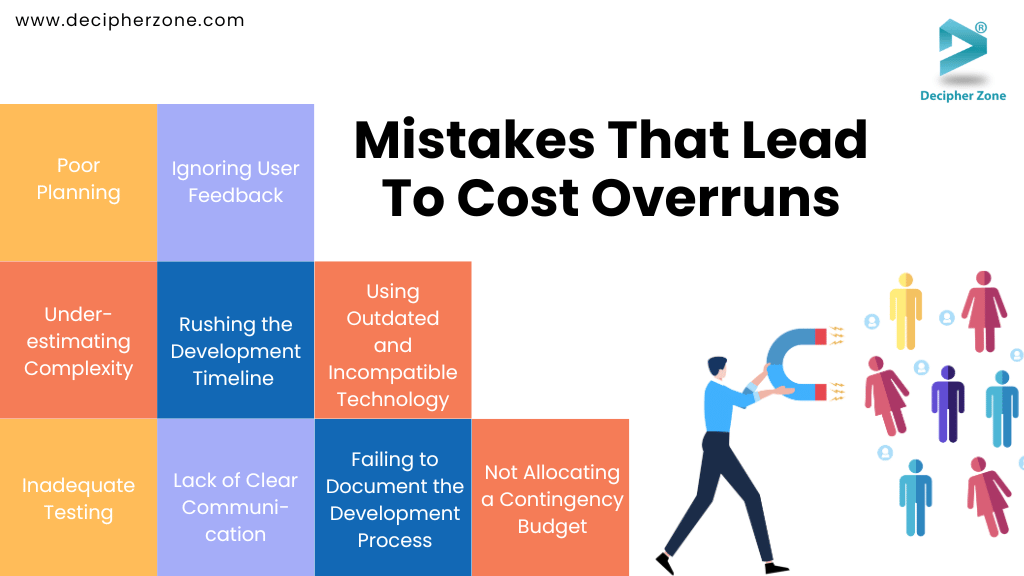To help you steer clear of typical pitfalls and understand hidden expenses in software development, take a look at this blog. This article addresses everything you need to lower your stress and better manage the costs associated with creating software solutions. Many businesses struggle with managing costs and often exceed their budgets.
Software development costs go beyond just coding and leave most businesses exceeding their budget in the end. This is the most common challenge businesses face and get into pitfalls.
Imagine you are setting out to build your dream house. You have carefully budgeted for the big ticket items including walls, floors, roof, plumbing, and electrical. Everything seems in order—until you discover the costs no one warned you about.
Suddenly, there are expenses for things like insulation, landscaping, permits, and inceptions. All those “small” things add up, and before you know it, your budget is stretched far beyond what you anticipated.
The cost of software development does not just only involve the coding and designing but they are layered, complex, and often filled with unexpected expenses.
In the beginning, everything seems straightforward: design, develop, deploy, but as the project unfolded, hidden costs creep in, from maintenance and security compliance to integration fees and even training costs. These invisible expenses can quickly snowball, stretching your budget and timelines far beyond your expectations.
Understanding the Basics of Software Development Costs
While on a software development project, it is easy to focus on the obvious costs–the ones you can see and plan for. But just as with building a house, the real expenses of software development often run deeper than the initial blueprint suggests. There are three types of costs in software development, direct, indirect, and hidden costs. Further, these can be explained—providing a clear understanding.
Types of Software Development Costs
Knowing the difference between direct, indirect, and hidden costs will help you get an overview and help you build a more realistic budget, and avoid unpleasant surprises.

Direct Costs
The direct costs are non-negotiable, visible, and necessary parts of the structure—more of the building blocks of the project. These direct costs include,
-
Development- The core of the software project which typically involves both frontend and backend development and can vary based on the complexity, tech stack, and the number of developers involved.
-
Design- To make the software user-friendly and visually appealing, UX (user experience) and UI (user interface) designs come in—helping the users navigate the software effortlessly. This makes the design phase and essential worth investing in.
-
Testing- This phase ensures the working of the software and is the most crucial phase. From functionality to security testing, it makes sure that the software works smoothly under all scenarios. Dealing with bugs early can cost usually much less than dealing with the issues after launch.
-
Deployment- This step makes the software available to the users. While it seems straightforward, deployment costs can vary depending on infrastructure needs and setup complexities.
Indirect Costs
The indirect costs are not considered at the initial stage but they are essential to keep the project on track and maintain its quality over time.
-
Overhead Costs- Project management, team collaboration tools, and administrative support aren’t directly linked to the code itself butt hey are crucial for coordinating the development process and ensuring everything runs smoothly.
-
Infrastructure- Infrastructure costs include servers, cloud storage, and other resources required to run the software. Cloud-based infrastructure like AWS or Azure can be a smart choice for scalability, but costs are based on usage and the level of service needed.
-
Maintenance- Regular maintenance is vital for keeping the software running smoothly and providing users with a seamless experience. It also helps ensure that the software stays compatible with new technologies.
Hidden Costs
The hidden costs are the sneaky expenses that can derail even the most carefully crafted budgets. They often pop up when you least expect them, turning your financial plans upside down!
-
Technical Debt- As developers resort to shortcuts to meet deadlines, they often find that refining or optimizing their work later can consume additional time and result in increased costs—ultimately contributing to technical debt.
-
Scope Creep- Those “just add one more feature” moments that extend the project timeline and add unforeseen costs. Without strong project management and clear boundaries, scope creep can spiral out of control.
-
Integration and Compatibility- Integrating with existing systems or third-party services can be challenging if systems aren’t designed to work together—raising issues that can lead to significant extra costs, as developers need to rework parts of the software to make everything function as intended.
-
Security and Compliance- Failing to prioritize data protection laws from the start can lead to costly compliance updates or worse a breach that damages both the reputation and finances.
-
Training and Documentation- Frequently overlooked training, user manuals, and documentation can be costly. Neglecting these elements can lead to inefficiency and dissatisfaction, especially if the user struggles to understand or adopt the software.
-
Project Delays- Due to unforeseen technical challenges, staffing issues, or dependency bottlenecks the project can be delayed which can lead to additional developer hours, project management time, and possibly penalties for missing deadlines—costing the project. Planning for some buffer time is wise, but lengthy delays can still impact the project’s overall budget and delivery schedule.
Mistakes That Lead To Cost Overruns of Software Development
In software development, certain missteps can lead to major cost overruns that could be avoided with proper planning and foresight. However, building software without the right strategy can be like setting off on a road trip without a map—you might eventually reach your destination, but it is likely to take longer, cost more, and leave you stressed along the way. Let’s look at the most common mistakes that drive up expenses and explore how to avoid them.
1. Poor Planning
In software development, insufficient planning has effects as without clear plans, you’d be constantly planning, potentially wasting resources on work that has to be redone. When requirements aren’t clearly defined from the start, unexpected needs arise, resulting in extra work that wasn’t accounted for in the budget.
This can lead to scope creep, project delays, and increased costs as the team scrambles to accommodate unanticipated features. Taking the time to thoroughly understand and document what’s needed at the beginning of the project can save significant time, money, and stress in the long run.
2. Underestimating Complexity
Software projects often seem simple in theory but turn out to be far more complex in practice. For example, developing an eCommerce site may seem straightforward, but adding secure payment processing, user accounts, and integrations with third-party services adds layers of complexity.
When project complexity is underestimated, additional development hours, expertise, and testing are often required—costs that quickly add up. Realistic budgeting should include a thorough review of the project’s technical requirements and an assessment of potential challenges to ensure there’s room in the budget to handle the project’s true scope.

3. Inadequate Testing
Skipping, rushing testing, or without rigorous testing, bugs or usability issues can slip through, leading to costly rework later. Insufficient testing during development can result in costly fixes after launch, particularly if critical errors impact user experience or data security. Post-launch debugging not only consumes additional time and money but also damages your reputation if users encounter these issues.
4. Ignoring User Feedback
User feedback, particularly early in development, provides valuable insights that help shape the software to fit actual needs. Ignoring user feedback is a common mistake that can result in a product that misses the mark, leading to costly revisions or worse, low user adoption. Incorporating user feedback early and often can prevent costly redesigning of layouts, reworking features, or adding functionality post-launch, and increase user satisfaction.
5. Rushing the Development Timeline
Rushing to meet aggressive timelines often results in shortcuts that compromise the quality of the final product. While meeting deadlines is important, rushing often leads to sloppy coding, unoptimized features, and skipped testing. Balancing urgency with quality ensures that the project stays on track without sacrificing performance or durability.
6. Lack of Clear Communication
Poor communication can result in developers creating solutions that later require significant revisions. When stakeholders, developers, and project managers don't communicate effectively, it often leads to misunderstandings, overlooked requirements, and unnecessary rework.
To prevent misalignment and the associated costs, it's vital to establish clear communication channels, provide regular updates on progress, and foster a mutual understanding of objectives.
7. Using Outdated and Incompatible Technology
Technology evolves quickly and using outdated or incompatible tools can be tempting but often leads to integration issues, performance bottlenecks, and limited scalability. However, in some cases, updating to newer technology down the line becomes a necessity, adding to the budget. Investing in a modern, compatible tech stack that aligns with your project’s needs is a cost-effective approach in the long run.
8. Failing to Document the Development Process
Proper documentation including code comments, technical specs, and usage guides provides a clear reference for the development team. Without documentation, future developers may struggle to understand the code, making it costly and time-consuming to update or troubleshoot.
9. Not Allocating a Contingency Budget
A contingency budget ranges from 10-20% of the total project budget, providing a safety net that keeps the project on track financially. With this, software projects can handle unforeseen costs–avoiding the scope of strain on the budget with unexpected expenses such as urgent fixes and hardware needs.
The Bottom Line
With this guide, you have a clear roadmap for navigating the unseen expenses of software development, along with practical tips for avoiding common pitfalls that lead to budget overrun.
If you're looking to avoid common pitfalls in software development, consider hiring a company that prioritizes transparent pricing and openly discusses any hidden costs.
Decipher Zone stands out as a leading software development firm, offering clear pricing models and a team of experienced developers ready to help you navigate risks and challenges effectively.

FAQs
-
How can I avoid scope creep in my software project?
Close collaboration with the development team, setting boundaries for features, and using a project management tool to track any changes can help minimize scope creep. Regular check-ins and clear documentation also help ensure everyone stays aligned on project goals and limits.
-
What’s the best way to prepare for hidden costs in a software project?
Clear requirements gathering, regular testing, user feedback integration, and planning for scalability are all proactive steps that reduce the likelihood of hidden costs. Also, prepare by allocating a contingency budget ranging between 10-20% of the total project for unexpected expenses.
-
What are the risks of using outdated technology for my software project?
Technology evolves quickly and using outdated or incompatible tools can be tempting but often leads to integration issues, performance bottlenecks, and limited scalability. However, in some cases, updating to newer technology down the line becomes a necessity, adding to the budget. Investing in a modern, compatible tech stack that aligns with your project’s needs is a cost-effective approach in the long run.

